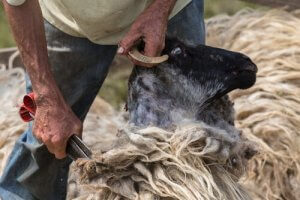All About Sheep Shearing


Written and verified by the lawyer Francisco María García
Sheep shearing isn’t just part of the wool trade, it’s also an important part of keeping these animals healthy. Anyone raising sheep needs to do this to preserve their well-being.
Physical characteristics and behavior of sheep
We generally use the term ‘sheep’ to describe a whole range of breeds that make up the species Ovis orientalis aries.
These ruminant animals have a polygastric digestive system, and their stomach is made up of four cavities. Their most obvious physical features are their robust body covered in thick wool and their muscular legs and hooves.
They’re very strong and agile creatures, but they’re also remarkably intelligent and sensitive. They also tend to be very energetic and quite alert to their surroundings.

Recent studies have demonstrated that sheep have great memories. The experiments carried out showed that they could recall events that had happened up to two years previously, as well as the emotions that they felt at the time.
Sheep shearing: the best breeds for wool production
The most common reason for raising sheep is for wool production, and it provides a livelihood for many farmers.
But if you’re thinking about raising sheep, it’s important to know more about the different breeds before you dive in. The more you know, the better you’ll be able to look after them and optimize your investment by choosing the most suitable breed.
– Optimal breeds for wool production: Merino and Rambouillet.
– Breeds for meat and wool: Corriedale, Polypay, Columbia, and Targhee.
Wool: a valuable natural fiber
The wool that covers a sheep’s body is a natural fiber. Done correctly, sheep shearing allows you to remove the wool without hurting the animal or waste this valuable fiber.
Wool is used to make a whole range of garments, from scarves and socks to very sophisticated coats. They’re much valued for their ability to keep you warm whilst staying soft and delicate.

After the shearing process, the wool is washed and sanitized before being used in weaving.
Sheep shearing: tips and considerations
Shearing sheep requires specific care and proper planning. Here are some practical tips to help you organize your first shearing.
1- Choose the right time of year
Shearing should be done once a year, allowing the sheep’s coat the recover both its length and quality.
The wool’s natural function is to protect the sheep from the cold out in the open. As a result, it’s best to shear your sheep during the spring or early summer.
2- Have the right tools
The oldest and most traditional method is to use sharp scissors. But these days, shearers use electric cutters to speed things up and minimize the risk of injury or cuts.
It’s essential to have the proper tools when shearing sheep. A good pair of electric cutters will have a handle, comb, and blades, and the blades should be sharp to provide a good cut without hurting the animal.
3- Prepare the sheep for shearing
Before you start shearing, gather the sheep into a pen and separate the lambs, ewes, and rams. We also recommend not feeding the sheep the day before you shear them.
You can’t shear a sheep if the wool is wet. Never try to shear a wet sheep or do it on rainy days.
It’s also important to take care of your sheep’s coat throughout the year to maintain its quality. A healthy sheep will produce a large amount of lanolin, a greasy substance that protects both their body and the quality of the wool.
Eventually, due to their age or health problems, the sheep may produce less lanolin. This makes the shearing difficult by clogging up the blades and this can impair the wool’s shine and thickness. There are commercial products available that can address this and improve your sheep’s health.
4- Search for professional shearers
Like everything in life, it’s always best to speak to a professional. Sheep shearing requires special knowledge and experience if you don’t want to injure the sheep or, indeed, yourself.
For this reason, it’s important to seek help from an experienced shearer to avoid making any mistakes when handling your sheep. They’ll guide you through the process and advise on the correct way to prepare the wool.
Sheep shearing isn’t just part of the wool trade, it’s also an important part of keeping these animals healthy. Anyone raising sheep needs to do this to preserve their well-being.
Physical characteristics and behavior of sheep
We generally use the term ‘sheep’ to describe a whole range of breeds that make up the species Ovis orientalis aries.
These ruminant animals have a polygastric digestive system, and their stomach is made up of four cavities. Their most obvious physical features are their robust body covered in thick wool and their muscular legs and hooves.
They’re very strong and agile creatures, but they’re also remarkably intelligent and sensitive. They also tend to be very energetic and quite alert to their surroundings.

Recent studies have demonstrated that sheep have great memories. The experiments carried out showed that they could recall events that had happened up to two years previously, as well as the emotions that they felt at the time.
Sheep shearing: the best breeds for wool production
The most common reason for raising sheep is for wool production, and it provides a livelihood for many farmers.
But if you’re thinking about raising sheep, it’s important to know more about the different breeds before you dive in. The more you know, the better you’ll be able to look after them and optimize your investment by choosing the most suitable breed.
– Optimal breeds for wool production: Merino and Rambouillet.
– Breeds for meat and wool: Corriedale, Polypay, Columbia, and Targhee.
Wool: a valuable natural fiber
The wool that covers a sheep’s body is a natural fiber. Done correctly, sheep shearing allows you to remove the wool without hurting the animal or waste this valuable fiber.
Wool is used to make a whole range of garments, from scarves and socks to very sophisticated coats. They’re much valued for their ability to keep you warm whilst staying soft and delicate.

After the shearing process, the wool is washed and sanitized before being used in weaving.
Sheep shearing: tips and considerations
Shearing sheep requires specific care and proper planning. Here are some practical tips to help you organize your first shearing.
1- Choose the right time of year
Shearing should be done once a year, allowing the sheep’s coat the recover both its length and quality.
The wool’s natural function is to protect the sheep from the cold out in the open. As a result, it’s best to shear your sheep during the spring or early summer.
2- Have the right tools
The oldest and most traditional method is to use sharp scissors. But these days, shearers use electric cutters to speed things up and minimize the risk of injury or cuts.
It’s essential to have the proper tools when shearing sheep. A good pair of electric cutters will have a handle, comb, and blades, and the blades should be sharp to provide a good cut without hurting the animal.
3- Prepare the sheep for shearing
Before you start shearing, gather the sheep into a pen and separate the lambs, ewes, and rams. We also recommend not feeding the sheep the day before you shear them.
You can’t shear a sheep if the wool is wet. Never try to shear a wet sheep or do it on rainy days.
It’s also important to take care of your sheep’s coat throughout the year to maintain its quality. A healthy sheep will produce a large amount of lanolin, a greasy substance that protects both their body and the quality of the wool.
Eventually, due to their age or health problems, the sheep may produce less lanolin. This makes the shearing difficult by clogging up the blades and this can impair the wool’s shine and thickness. There are commercial products available that can address this and improve your sheep’s health.
4- Search for professional shearers
Like everything in life, it’s always best to speak to a professional. Sheep shearing requires special knowledge and experience if you don’t want to injure the sheep or, indeed, yourself.
For this reason, it’s important to seek help from an experienced shearer to avoid making any mistakes when handling your sheep. They’ll guide you through the process and advise on the correct way to prepare the wool.
This text is provided for informational purposes only and does not replace consultation with a professional. If in doubt, consult your specialist.








